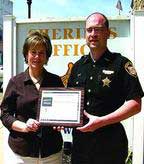Angels on Track
Honors Hale for His Dedication to Keeping Crossings Safe
Mr. Thrifty
April 30, 2008
By: KIMBERLY LEWIS

Photo By Kimberly Lewis
Vicky Moore, a trustee with the Angels on Track Foundation,
recognizes Edward Hale, a Carroll County Sheriff's deputy,
for his commitment to keeping railroad crossings safe.
The Angels on Track Foundation honored
Carroll County Sheriff Deputy Edward Hale April 24, at the
sheriff's office for his "dedication
to identifying hazards at railroad crossings."
Hale was presented with a safety award
from Vicky Moore, a trustee for the Angels on Track Foundation,
for his enforcement of a state ordinance requiring railroads
to keep crossings clear of vegetation to allow drivers a
clear view of any oncoming trains. Hale was commended for
his "personal commitment
to ensure all railroad crossings in Carroll and surrounding
counties are clear of sight obstructions in accordance to Ohio
Revised Code. ... The Angels on Track Foundation recognizes
Deputy Edward Hale's work to prevent future accidents and fatalities
at dangerous sight-obstructed railroad crossings."
"I have no issues with trains and railroads as a person;
however, when a section of the Ohio Revised Code and the safety
of the public was hindered at that one crossing, I felt that
as a sworn law-enforcement officer, the Ohio Revised Code 4955.36
law needed to be enforced," said Hale.
That crossing was "an accident waiting to happen." That
was how a concerned citizen described a dangerous Wheeling
and Lake Erie railroad crossing at the intersection of state
Route 39 and Crane Road in Sherrodsville in July 2006.
According to Hale, a concerned citizen
pointed out the weeds, trees and bushes near the crossing
and that "it is hard
to see down the rail line when stopped at the white stop bar." Hale
drove up to the stop bar and discovered the view of the rail
line was indeed hindered by the trees and bushes.
"When you move forward pass the
white stop bar and look to your right side, then you can
obtain a clear view of the entire area. At this point however
you are now in what is known as 'the dead zone,' and that
is when you are between the white stop bar and the nearest
rail. This crossing is a marked crossing with all the required
lights, signs, and crossing gates, and is operated by the
Wheeling Lake Erie Railway."
After speaking with Tom Cottis of the Carroll County Emergency
Management Agency and obtaining an aerial photo of the Wheeling
Lake Erie Railway crossing in the village of Sherrodsville
and a copy of the plat map of the same area, Hale contacted
Wheeling and Lake Erie Railway and the Public Utilities Commission.
"As a result of Deputy Hale's efforts, W&LE sent
a maintenance crew to remove weeds and vegetation, in addition
to a large tree, that was blocking motorists from seeing down
the tracks," said Moore. "Even though this crossing
was equipped with gates, in the event they malfunctioned or
didn't activate, a driver needs to be able to see down the
tracks for an oncoming train."
"Ohio is one of very few states that have legislation
addressing vegetation or sight distance clearances for public
safety," Moore said. "All the more reason for the
law to be followed by railroad companies operating in Ohio.
They also need to keep their rights-of-way cleared on a regular
basis, not just clearing after a collision or following a complaint.
There are no fines for non-compliance, thus no incentive for
railroad companies to follow the law. Lawmakers need to support
large fines."
In Ohio, about 44 percent of public
crossings have "crossbucks," black
letters in an "X" spelling railroad crossing. Only
about 36 percent of public crossings have automated gates.
Private crossings often have no protective and/or warning devices.
Only approximately 27 percent of public crossings in the U.S.
are gated.
The foundation recently added a section, "Call to Action,
Fill Out A Dangerous Crossing Report (DCR)," where citizens
from Ohio can report hazards at railroad crossings for dangers
such as sight obstructions, blocked crossings, activation failures,
false activations, in addition to other existing dangers at
crossings. State agencies are paying attention to these reports
and are using them to identify crossings for gate installations
and addressing crossing concerns.
|